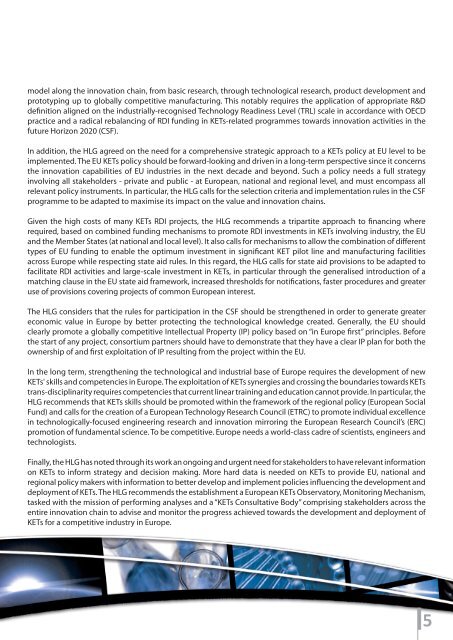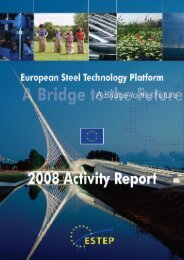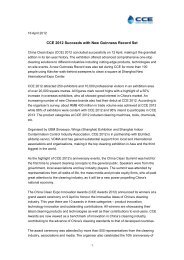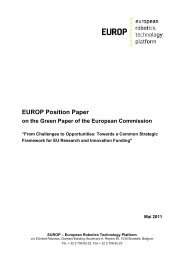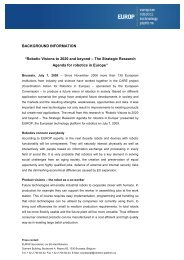Final report on Key Enabling Technologies - European Commission ...
Final report on Key Enabling Technologies - European Commission ...
Final report on Key Enabling Technologies - European Commission ...
Create successful ePaper yourself
Turn your PDF publications into a flip-book with our unique Google optimized e-Paper software.
model al<strong>on</strong>g the innovati<strong>on</strong> chain, from basic research, through technological research, product development and<br />
prototyping up to globally competitive manufacturing. This notably requires the applicati<strong>on</strong> of appropriate R&D<br />
definiti<strong>on</strong> aligned <strong>on</strong> the industrially-recognised Technology Readiness Level (TRL) scale in accordance with OECD<br />
practice and a radical rebalancing of RDI funding in KETs-related programmes towards innovati<strong>on</strong> activities in the<br />
future Horiz<strong>on</strong> 2020 (CSF).<br />
In additi<strong>on</strong>, the HLG agreed <strong>on</strong> the need for a comprehensive strategic approach to a KETs policy at EU level to be<br />
implemented. The EU KETs policy should be forward-looking and driven in a l<strong>on</strong>g-term perspective since it c<strong>on</strong>cerns<br />
the innovati<strong>on</strong> capabilities of EU industries in the next decade and bey<strong>on</strong>d. Such a policy needs a full strategy<br />
involving all stakeholders - private and public - at <strong>European</strong>, nati<strong>on</strong>al and regi<strong>on</strong>al level, and must encompass all<br />
relevant policy instruments. In particular, the HLG calls for the selecti<strong>on</strong> criteria and implementati<strong>on</strong> rules in the CSF<br />
programme to be adapted to maximise its impact <strong>on</strong> the value and innovati<strong>on</strong> chains.<br />
Given the high costs of many KETs RDI projects, the HLG recommends a tripartite approach to financing where<br />
required, based <strong>on</strong> combined funding mechanisms to promote RDI investments in KETs involving industry, the EU<br />
and the Member States (at nati<strong>on</strong>al and local level). It also calls for mechanisms to allow the combinati<strong>on</strong> of different<br />
types of EU funding to enable the optimum investment in significant KET pilot line and manufacturing facilities<br />
across Europe while respecting state aid rules. In this regard, the HLG calls for state aid provisi<strong>on</strong>s to be adapted to<br />
facilitate RDI activities and large-scale investment in KETs, in particular through the generalised introducti<strong>on</strong> of a<br />
matching clause in the EU state aid framework, increased thresholds for notificati<strong>on</strong>s, faster procedures and greater<br />
use of provisi<strong>on</strong>s covering projects of comm<strong>on</strong> <strong>European</strong> interest.<br />
The HLG c<strong>on</strong>siders that the rules for participati<strong>on</strong> in the CSF should be strengthened in order to generate greater<br />
ec<strong>on</strong>omic value in Europe by better protecting the technological knowledge created. Generally, the EU should<br />
clearly promote a globally competitive Intellectual Property (IP) policy based <strong>on</strong> “in Europe first” principles. Before<br />
the start of any project, c<strong>on</strong>sortium partners should have to dem<strong>on</strong>strate that they have a clear IP plan for both the<br />
ownership of and first exploitati<strong>on</strong> of IP resulting from the project within the EU.<br />
In the l<strong>on</strong>g term, strengthening the technological and industrial base of Europe requires the development of new<br />
KETs' skills and competencies in Europe. The exploitati<strong>on</strong> of KETs synergies and crossing the boundaries towards KETs<br />
trans-disciplinarity requires competencies that current linear training and educati<strong>on</strong> cannot provide. In particular, the<br />
HLG recommends that KETs skills should be promoted within the framework of the regi<strong>on</strong>al policy (<strong>European</strong> Social<br />
Fund) and calls for the creati<strong>on</strong> of a <strong>European</strong> Technology Research Council (ETRC) to promote individual excellence<br />
in technologically-focused engineering research and innovati<strong>on</strong> mirroring the <strong>European</strong> Research Council’s (ERC)<br />
promoti<strong>on</strong> of fundamental science. To be competitive. Europe needs a world-class cadre of scientists, engineers and<br />
technologists.<br />
<str<strong>on</strong>g>Final</str<strong>on</strong>g>ly, the HLG has noted through its work an <strong>on</strong>going and urgent need for stakeholders to have relevant informati<strong>on</strong><br />
<strong>on</strong> KETs to inform strategy and decisi<strong>on</strong> making. More hard data is needed <strong>on</strong> KETs to provide EU, nati<strong>on</strong>al and<br />
regi<strong>on</strong>al policy makers with informati<strong>on</strong> to better develop and implement policies influencing the development and<br />
deployment of KETs. The HLG recommends the establishment a <strong>European</strong> KETs Observatory, M<strong>on</strong>itoring Mechanism,<br />
tasked with the missi<strong>on</strong> of performing analyses and a “KETs C<strong>on</strong>sultative Body” comprising stakeholders across the<br />
entire innovati<strong>on</strong> chain to advise and m<strong>on</strong>itor the progress achieved towards the development and deployment of<br />
KETs for a competitive industry in Europe.<br />
5


